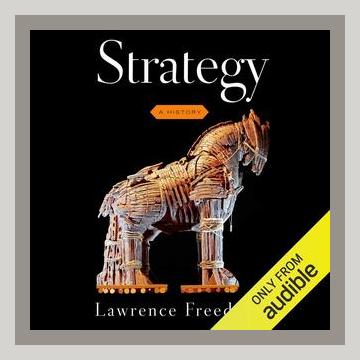Business StrategyStrategic PlanningStrategic Execution
“Strategy: A History” by Lawrence Freedman comprehensively explores the evolution and application of strategy across different domains, from military and politics to business and everyday life. Freedman’s approach is both historical and analytical, offering readers a deep dive into how strategy has been conceived and practiced over millennia. This summary outlines the major points of the book and provides concrete examples and actionable steps for each key area discussed.
Introduction to Strategy
Freedman starts by defining strategy as a plan or policy designed to achieve a major or overall aim. Strategy is distinguished from tactics—it is long-term and overarching rather than immediate and detailed.
Actionable Step:
– Understand the Difference: Before devising any plan, ensure clarity on your ultimate long-term goals (strategy) versus the short-term actions or steps (tactics) you’ll use to achieve them.
Military Origins of Strategy
Freedman delves deeply into the origins of strategy in military contexts, tracing back to Sun Tzu’s “The Art of War” and Carl von Clausewitz’s “On War.” Sun Tzu emphasized deception and flexibility, while Clausewitz focused on the “fog of war” and the unpredictability of conflict.
Example:
– Sun Tzu’s Principle: “All warfare is based on deception.” This concept can be seen in business strategies where companies might launch misleading marketing campaigns to confuse competitors.
Actionable Step:
– Embrace Flexibility: Regularly assess your strategy and be willing to adapt. This could mean altering marketing plans in business or shifting focus areas in a project based on changing conditions.
Political Strategy
The book also covers political strategy, with a particular focus on Niccolò Machiavelli’s “The Prince,” which is considered a seminal work on political strategy and power. Machiavelli emphasized the importance of pragmatism and the sometimes harsh realities of leadership.
Example:
– Machiavelli’s Principle: “The ends justify the means” is a controversial yet widely referenced point in political and business strategies. Strategies in lobbying, for instance, often employ this pragmatism.
Actionable Step:
– Prioritize Results: In your strategic planning, sometimes unconventional or tough decisions need to be made to achieve long-term objectives.
Business Strategy
Freedman examines business strategies, referencing influential figures like Alfred Sloan of General Motors and modern strategists such as Michael Porter. Sloan’s development of a decentralized organizational structure revolutionized GM, while Porter’s Five Forces model remains a foundational business strategy tool.
Examples:
– Sloan’s Decentralization: This allowed different GM divisions to operate autonomously while aligning with the overall corporate strategy.
– Porter’s Five Forces: It includes competitive rivalry, the threat of new entrants, and the bargaining power of suppliers and customers.
Actionable Steps:
– Adopt Decentralization: Consider allowing teams or departments within your organization more autonomy to foster innovation and responsiveness.
– Analyze Competitively: Use Porter’s Five Forces to regularly assess your competitive position and adapt your strategies accordingly.
Psychological and Behavioral Strategy
Another key area Freedman explores is the psychological dimension of strategy, particularly decision-making and human behavior under strategic settings. He references Daniel Kahneman’s work on cognitive biases and heuristics, which affect judgment and decision-making.
Example:
– Kahneman’s Insight: People often rely on heuristics or mental shortcuts that can lead to errors in judgment, influencing both personal and organizational strategies.
Actionable Step:
– Mitigate Biases: Implement checks and balances in strategic decision-making processes to minimize cognitive biases. This might involve diverse perspectives or systematic analytical methods.
Strategic Execution and Implementation
Freedman also addresses the crucial aspect of executing a strategy effectively, emphasizing that even the most well-conceived strategies can fail if not properly implemented. Historical and contemporary examples illustrate the gap that often exists between strategic planning and execution.
Examples:
– Operation Barbarossa: The German invasion of the Soviet Union during World War II, which failed due to over-extension and poor execution despite initial successes.
– Business Failures: Often successful business strategies falter due to poor communication, lack of commitment, or resistance to change.
Actionable Step:
– Detailed Execution Plan: Develop a clear, detailed plan for implementing your strategy. Assign responsibilities, set timelines, and establish measurable outcomes to track progress.
Adaptive Strategies
Freedman discusses the concept of adaptive strategies, where flexibility and the ability to pivot are crucial. He cites instances like Toyota’s lean manufacturing and its ability to innovate and adapt to market demands.
Example:
– Toyota’s Lean Manufacturing: Emphasizes efficiency and waste reduction, allowing Toyota to adapt quickly to changes and maintain a competitive edge.
Actionable Step:
– Foster Adaptability: Encourage a culture of continuous improvement and flexibility. Regularly review and adapt strategies based on feedback and environmental changes.
Ethical Considerations in Strategy
Ethics is another underlying theme in Freedman’s analysis of strategy. He recognizes the moral dimensions that strategists must grapple with, balancing effectiveness with ethical considerations.
Example:
– Corporate Social Responsibility (CSR): Businesses are increasingly integrating CSR into their strategies, balancing profit-making with societal good.
Actionable Step:
– Integrate Ethics: Ensure your strategic plans consider their impact on stakeholders and the broader community. Align your strategies with ethical standards and promote transparency and accountability.
Case Studies and Historic Lessons
The book is rich with case studies ranging from historic battles to corporate maneuvers, illustrating that successful strategies often involve learning from past failures and leveraging lessons learned.
Examples:
– The Battle of Midway: A turning point in World War II, highlighting the importance of intelligence and surprise.
– Apple’s Innovation Strategy: Apple’s ability to consistently innovate and disrupt markets.
Actionable Step:
– Learn from History: Regularly analyze past strategies within your industry or field to understand successes and failures. Apply these insights to your planning process.
Conclusion
Lawrence Freedman’s “Strategy: A History” is a monumental work that offers a thorough examination of strategy across various fields. The essence of the book is not just in understanding historical strategies but applying these lessons to modern challenges. Whether in military, politics, business, or personal planning, the principles, case studies, and actionable steps derived from the book serve as a valuable guide for anyone looking to master the art of strategic thinking and execution.
